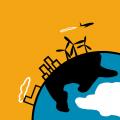
This Guide for Educators was developed by the MIT Environmental Solutions Initiative as an extension of our TILclimate (Today I Learned: Climate) podcast, to make it easier for you to teach climate change, earth science, and energy topics in the classroom. It is an extension of the TILclimate episode "TIL about geoengineering."
Browse all TILclimate guides for educators.
Description
Geoengineering includes a host of technologies and practices that seek to reduce the amount of heat trapped in Earth’s atmosphere. Some of these technologies could have significant side effects that are not well understood. Who decides when or how to engineer the Earth’s atmosphere?
SWBAT:
-
Describe some key geoengineering technologies
-
Understand some of the potential benefits and concerns about geoengineering
Skills:
-
Reading and discussing scientific writing
-
Science communication
Standards:
-
HS-ESS2-2 Analyze geoscience data to make the claim that one change to Earth’s surface can create feedbacks that cause changes to other Earth systems.
-
HS-ESS2-4 Use a model to describe how variations in the flow of energy into and out of Earth’s systems result in changes in climate.
-
HS-ETS1-1 Analyze a major global challenge to specify qualitative and quantitative criteria and constraints for solutions.
-
RST.11-12.2 Determine the central ideas or conclusions of a text; summarize complex concepts, processes, or information presented in a text by paraphrasing them in simpler but still accurate terms.
Disciplinary core ideas:
-
ESS2.A Earth Materials and Systems
-
ESS2.D Weather and Climate
-
ESS3.C Human Impacts on Earth Systems
-
ESS3.D Global Climate Change
What is included in this Educator Guide
- How to use TILclimate Educator Guides (Download)
- Full Educator Guide (Download)
- Includes both Teacher and Student pages
- Includes both Teacher and Student pages
- Teacher pages (Download)
- Includes materials, discussion questions, background resources, and adaptation suggestions for science, social science, and ELA teachers
- Includes materials, discussion questions, background resources, and adaptation suggestions for science, social science, and ELA teachers
- Student pages (Download)
-
Reading: Volcanoes and a Cooling Earth
-
Read & Discuss: How do we Decide?
-
Glossary: Geoengineering
-
Listen to the episode


